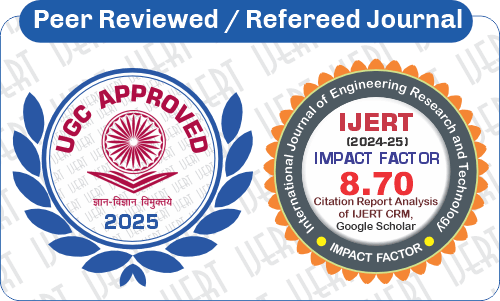 DOI : 10.17577/IJERTV14IS030043
DOI : 10.17577/IJERTV14IS030043

- Open Access

- Authors : Shaiiendra Kumar, Vaishali Sharma, Vanshdeep
- Paper ID : IJERTV14IS030043
- Volume & Issue : Volume 14, Issue 03 (March 2025)
- Published (First Online): 19-03-2025
- ISSN (Online) : 2278-0181
- Publisher Name : IJERT
- License:
 This work is licensed under a Creative Commons Attribution 4.0 International License
This work is licensed under a Creative Commons Attribution 4.0 International License
Data -Driven Analysis of the Impact of COVID-19
Shaiiendra Kumar
School Of Computer Application and Technology, Galgotias University, Greater Noida, Uttar Pradesh,
India
Vanshdeep
School of Computer Application and Technology, Galgotias University, Greater Noida, Uttar Pradesh,
India
Vaishali Sharma
School Of Computer Application and Technology, Galgotias University, Greater Noida, Uttar Pradesh,
India
ABSTRACT
This project introduces a system for analyzing and predicting COVID-19 trends using data-driven methods. Utilizing datasets from sources like WHO and Johns Hopkins University, the system preprocesses data to address missing values, inconsistencies, and normalization needs. It applies models such as Linear Regression, Support Vector Machines, and LSTM networks for trend prediction. Techniques like feature scaling and dimensionality reduction enhance accuracy, with evaluation metrics including MAE and RMSE ensuring reliability. Cross- validation confirms robust performance, providing actionable insights for public health decisions.
I.INTRODUCTION
Coronavirus ailment 2019 (COVID-19), as a result of the SARS-CoV-2 virus, has unfold global due to the fact that December 2019. the world health company (WHO) declared COVID-19 as a plague on March 11, 2020 [1,2,3,4]. The outbreak has had a chief impact on healthcare structures and the global economy [5]. because of the complexity of the COVID- 19 outbreak, it is difficult for present fashions to determine the route and dynamics of the outbreak [6]. therefore, it turns into vital to broaden quantitative size models to higher apprehend the global spread of COVID-19 and the influencing elements. in this context, deep mastering models had been a success in analyzing time collection facts[7]. other signs and symptoms include problem breathing and chest pain[8]. To save you the spread of the virus, countries have carried out various measures such as banning gatherings, restricting movement, encouraging using masks, and often disinfecting the general public[9]. As of February 31, 2021, there were extra than 287 million showed COVID- 19 instances and at least 5 million deaths worldwide[10]. To better recognize the elements affecting the spread of SARSCoV-2, support effective disease prevention decisions, and put in force response plans, reading the relationship between sicknesses is critical.
-
LLTRATURE REVIEW
The COVID-19 virus has brought about a international health crisis, causing economic, social and mental damage. journey around the sector. From an financial perspective, the pandemic has brought on concerns about the worldwide economic system due to commercial enterprise closures and disruption of supply
chains. From a social angle, issues together with home violence, malnutrition due to college closures and distance mastering have gained importance. From a psychological perspective, the pandemic has brought on pressure, anxiety, despair and different intellectual fitness problems, and experts warn that the results can be long-time period. Social distancing measures have led many humans to paintings remotely; in Poland, round 75% of personnel have been operating from home given that the beginning of 2020. humans are handling this in a ramification of ways, along with stress or undertaking risky management behaviors. for instance, people with excessive degrees of tension are much more likely to experience misery for the duration of herbal disasters, whilst folks that experience out of manage are more likely to be laid low with events like earthquakes. Pandemics and natural disasters percentage the identical traits of disrupting day by day life and growing worry. but the coronavirus is a global pandemic in its own proper, with extra deaths in 2020 than in all herbal screw ups combined during the last 20 years. all through instances of crisis, human beings often hotel to avoidance behaviors, which includes staying domestic, to lessen risk. problem-fixing strategies, specially the ones of docs, are frequently targeted on problem fixing. even as social support performs an important position, poor coping strategies (along with substance use) are related to extra depression and suicidal mind, as are integration (such as the exercise of remembering and locating meaning) and connection (together with developing and retaining (lucky) connections).[11-26]
-
METHODOLOGY
William Stephenson, who received his doctorate in phy sics and psychology, developed the Q method in 1935. A type of fact checking method. The Q method was developed for ed ucational purposes and is widely used in medicine, edu cation, business, transportation and agriculture. The te am that prepared the explanation had to split up. This order is then analyzed and different perspectives are determined.
While the Q process often involves small sa mples, Van Exel and De Graaf emphasize that this proc ess focuses on ideas rather than large numbers and ai ms to identify groups and theoretical models. Data wer e collected from reliable sources such as the Ministry o f Health, District Offices (CDO/ DAO), and local governm ents through phone interviews and emails. The data co Ilected included the number of infections (by gender a nd age), the number of cases, the number of recoverie s, the number of deaths, the number of people in quar antine, and testing measures (PCR and RDT tests). The collected data was organized using Microsoft Excel and presented with visual tools such as bar charts, line char ts, and graphs. This helped in comparing and analyzing trends in COVID 19 cases that were clearly explained in the context of t he study. Their study is excellent at presenting patterns and structures clearly. [27]
-
RESULT
Of the 1,678,995 patients hospitalized with COVID-19, 222,615 died in hospital, for an overall hospital mortality rate of 13.2%. Figure 1 shows monthly changes in hospitalizations and deaths.
COVID-19 Hospitalizations and Mortality by Month
The study examined data from more than 1.6 million hospitalized COVID-19 patients, the largest study of its kind. The results showed that the overall mortality rate for hospitalized patients was 13.2%, with higher mortality rates in severe cases requiring mechanical ventilation. High blood pressure is the most common underlying condition, followed by diabetes. Patients who are older, male, obese, have kidney disease, heart disease, or cancer are at higher risk of death. Black, Hispanic, and Native American patients were twice as likely to die as white patients. Additionally, individuals from lowincome families are at greater risk for major outcomes, indicating a disparity that requires intervention. 192,550 patients reported an in-hospital mortality of 13.6%, which is very close to the results of this analysis..
FIG 2. Central illustration.
The association between cardiovascular disease and increased risk of death may be attributed to factors such as infectious hypoxia, acute inflammatory responses, and direct muscle damage. The finding that genderrelated mortality differences are associated with changes in angiotensin-converting enzyme 2 (ACE-2) expression supports previous studies. Based on NIS data using ICD-IO-CM codes, which may lead to misclassification of COVID-19. The findings were also limited by the rapid revision and lack of data on vaccination, clinical surveillance, and treatment. However, the large sample sizes and anecdotal evidence provided clear insights that are important to the American public and disparities in COVID-19 outcomes. This study continues to explore the potential mechanisms behind this finding while highlighting the importance of reducing disparities in healthcare and mortality. [28-30]
-
CONCLUSION
The COVID-19 pandemic has shown that the world is still facing a serious public health crisis, with major health, social and economic crises. copy and social. The pandemic takes many forms and has varying degrees of severity across regions and countries. Countries experiencing poor governance, poor health and social unrest have been hit harder than others. These include improving health emergency management, strengthening health systems, reducing fragmentation and addressing social inequalities. Achieving this goal is possible through a primary health care (PHC) approach that ensures universal access to quality health services, strengthens communities and encourages collaboration across multiple authorities to promote healthy living. No country is safe unless all countries are safe it was said in every corner. This is a strong call for a strong global health system based on the principles of fair and equitable care.
REFERENCES
-
Yunbo X.S.W. Novel coronavirus pneumonia epidemic and China's urban population and the spatial relationship between the city's public health classification governance enlightenment. Trop. Geogr.
-
Sharifi A., Khavarian-Garmsir A.R. The COVID-19 pandemic: Impacts on cities and major lessons for urban planning,design,andmanagement.Total
.142391.
-
Conforti C., Giuffrida R., Dianzani C., Di Meo N., Zalaudek l. COVID-19 and psoriasis: Is it time to limit treatment with immunosuppressants? A call for action.
-
Arora P., Jafferany M., Lotti T., Sadoughifar R., Goldust
M. Learning from history: Coronavirus outbreaks in the
-
Velavan T.P., Meyer C.G. The COVID-19 epidemic. Trop.
-
Fauci A.s., Lane H.c., Redfield R.R. COVID-19 Navigating the Uncharted. N. Engl. J. Med.
-
Namasudra S., Dhamodharavadhani S., Rathipriya R. Nonlinear neural network based forecasting model for predicting COVID-19 cases. Neural Process. Lett. 2021:1- 21.
-
Yuki K., Fujiogi M., Koutsogiannaki S. COVID-19 pathophysiology:A review.Clin.Immuno 10.1016/j.clim.2020doi: 10.1136/bmj.m810.
-
Haynes B.F., Corey L., Fernandes P., Gilbert P.B., Hotez P.J., Rao S. , Santos M.R., Schuitemaker H., Watson M., Arvin A. Prospects for a safe COVID-19 vaccine. Sci.
Transl. Med.
-
Cross R.M. Exploring attitudes: The case for Q methodology. Health Educ. Res. 2005;20:206213.
-
Watts S., Stenner P. Theory, Method and Interpretation. SAGE Publications Ltd.; New York, NY, USA: 2012. Doing Q methodological research; p. 2012.
-
Brown S.R. Political Subjectivity: Applications of Q Methodology in Political Science. Yale University Press; New Haven, CT, USA: 1980.
-
Ho G.W. Examining perceptions and attitudes: A review of Likert-type scales versus Q-methodology. West. J. Nurs. Res.
-
Van Exel J., De Graaf G. Q Methodology: A Sneak Preview. 2005. [(accessed on 11 March 2021)].
-
Paige J.B., Morin K.H. Using Q-methodology to reveal nurse educators' perspectives about simulation design. Clin. Simul. Nurs.
-
Stenner P., Cross V., McCrum C., McGowan J., Defever E. , Lloyd p. , Poole R. , Moore A.p. Selfmanagement of chronic low back pain: Four viewpoints from patients and healthcare providers. Health Psychol.
-
Stenner P., Dancey C., Watts S. The understanding of their illness amongst people with irritable bowel syndrome: A Q methodological study. Soc. Sci. Med.
-
Stenner P., Rogers R.S. In: The Example of Discriminating between Emotions. Todd Z., Nerlich B.
, McKeown S., Clarke D.D., editors. Psychology Press; New York, NY, USA: 2004. pp. 101-121. Mixing Methods in Psychology: The Integration of Qualitative and Quantitative Methods in Theory and Practice.
-
Ha E.-H. Undergraduate nursing students' subjective attitudes to curriculum for Simulation-based objective structured clinical examination. Nurse Educ. Today.
-
Petit dit Dariel 0., Wharrad H. , Windle R. Exploring the underlying factors influencing e-learning adoption in nurse education. J. Adv. Nurs.
-
Van Exel N., De Graaf G., Rietveld P. I can do perfectly well without a car! Transportation. 2011;38:383407.
-
Davies B.B., Hodge I.D. Shifting environmental perspectives in agriculture: Repeated Q analysis and the stability of preference structures. Ecol. Econ.
-
Ladan M.A., Wharrad H., Windle R. eHealth adoption and use among healthcare professionals in a tertiary hospital in Sub-Saharan Africa: A Qmethodology study. PeerJ.
-
Webler T., Danielson S. , Tuler S. Using Q method to reveal social perspectives in environmental research. Greenfield MA Soc. Environ. Res. Inst. 2009;54:145.
-
Valenta A.L., Wigger U. Q-methodology: Definition and application in health care informatics. J. Am. Med. Inform.Assoc.1997;4:501510.
-
Thomas D.B., Baas L.R. The issue of generalization in Qmethodology:"Reliable schematics" revisited. Operant Subj.
-
Paige J.B., Morin K.H. Q-sample construction: A critical step for a Q-methodological study. West. J. Nurs.
-
NT Nguyen, J Chinn, J Nahmias, S Yuen, KA Kirby, S H ohmann, et al.
Outcomes and mortality among adults hospitalized with COVID-19 at US Medical Centers
JAMA Network open, 4 (2021), Article e210417
-
JAW Gold, KK Wong, CM Szablewski, PR Patel, J Ross ow, J da Silva, et al.
Characteristics and clinical outcomes of adult patients hospitalized with COVID-19 – Georgia, March 2020 MMWR Morb Mortal Wkly Rep, 69 (2020), pp. 545-550




